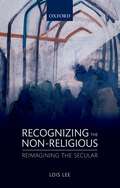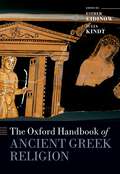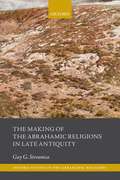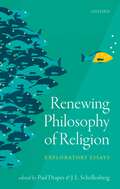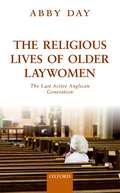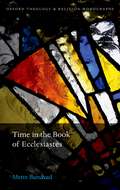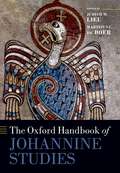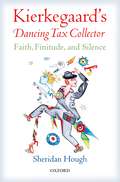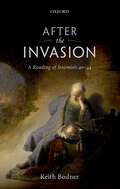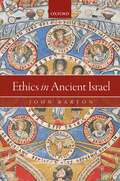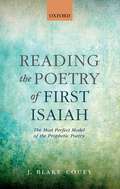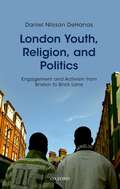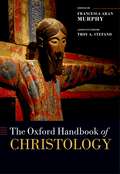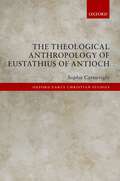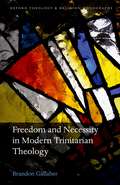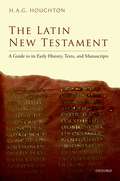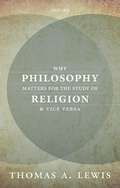- Table View
- List View
Recognizing the Non-religious: Reimagining the Secular
by Lois LeeIn recent years, the extent to which contemporary societies are secular has come under scrutiny. At the same time, many countries, especially in Europe, have increasingly large nonaffiliate, 'subjectively secular' populations, whilst nonreligious cultural movements like the New Atheism and the Sunday Assembly have come to prominence. Making sense of secularity, irreligion, and the relationship between them has therefore emerged as a crucial task for those seeking to understand contemporary societies and the nature of modern life. Drawing on ethnographic fieldwork in southeast England, Recognizing the Non-religious develops a new vocabulary, theory and methodology for thinking about the secular. It distinguishes between separate and incommensurable aspects of so-called secularity as insubstantial—involving merely the absence of religion—and substantial—involving beliefs, ritual practice, and identities that are alternative to religious ones. Recognizing the cultural forms that present themselves as non-religious therefore opens up new, more egalitarian and more theoretically coherent ways of thinking about people who are 'not religious'. It is also argued that recognizing the nonreligious allows us to reimagine the secular itself in new and productive ways. This book is part of a fast-growing area of research that builds upon and contributes to theoretical debates concerning secularization, 'desecularization', religious change, postsecularity and postcolonial approaches to religion and secularism. As well as presenting new research, this book gathers insights from the wider studies of nonreligion, atheism, and secularism in order to consolidate a theoretical framework, conceptual foundation and agenda for future research.
The Oxford Handbook of Ancient Greek Religion (Oxford Handbooks)
This handbook offers both students and teachers of ancient Greek religion a comprehensive overview of the current state of scholarship in the subject, from the Archaic to the Hellenistic periods. It not only presents key information, but also explores the ways in which such information is gathered and the different approaches that have shaped the area. In doing so, the volume provides a crucial research and orientation tool for students of the ancient world, and also makes a vital contribution to the key debates surrounding the conceptualization of ancient Greek religion. The handbook's initial chapters lay out the key dimensions of ancient Greek religion, approaches to evidence, and the representations of myths. The following chapters discuss the continuities and differences between religious practices in different cultures, including Egypt, the Near East, the Black Sea, and Bactria and India. The range of contributions emphasizes the diversity of relationships between mortals and the supernatural - in all their manifestations, across, between, and beyond ancient Greek cultures - and draws attention to religious activities as dynamic, highlighting how they changed over time, place, and context.
The Oxford Handbook of Ancient Greek Religion (Oxford Handbooks)
by Esther Eidinow and Julia KindtThis handbook offers both students and teachers of ancient Greek religion a comprehensive overview of the current state of scholarship in the subject, from the Archaic to the Hellenistic periods. It not only presents key information, but also explores the ways in which such information is gathered and the different approaches that have shaped the area. In doing so, the volume provides a crucial research and orientation tool for students of the ancient world, and also makes a vital contribution to the key debates surrounding the conceptualization of ancient Greek religion. The handbook's initial chapters lay out the key dimensions of ancient Greek religion, approaches to evidence, and the representations of myths. The following chapters discuss the continuities and differences between religious practices in different cultures, including Egypt, the Near East, the Black Sea, and Bactria and India. The range of contributions emphasizes the diversity of relationships between mortals and the supernatural - in all their manifestations, across, between, and beyond ancient Greek cultures - and draws attention to religious activities as dynamic, highlighting how they changed over time, place, and context.
The Making of the Abrahamic Religions in Late Antiquity (Oxford Studies in the Abrahamic Religions)
by Guy G. StroumsaThis book presents how ancient Christianity must be understood from the viewpoint of the history of religions in late antiquity. The continuation of biblical prophecy runs like a thread from Jesus through Mani to Muhammad. And yet this thread, arguably the single most important characteristic of the Abrahamic movement, often remains outside the mainstream, hidden, as it were, since it generates heresy. The figures of the Gnostic, the Holy man, and the mystic are all sequels of the Israelite prophet. They reflect a mode of religiosity that is characterized by high intensity. It is centripetal and activist by nature and emphasizes sectarianism and polemics, esoteric knowledge, or gnosis and charisma. The other mode of religiosity, obviously much more common than the first one, is centrifugal and irenic. It favours an ecumenical attitude, contents itself with a widely shared faith, or pistis, and reflects, in Weberian parlance, the routinisation of the new religious movement. This is the mode of priests and bishops, rather than that of martyrs and holy men. These two main modes of religion, high versus low intensity, exist simultaneously, and cross the boundaries of religious communities. They offer a tool permitting us to follow the transformations of religion in late antiquity in general, and in ancient Christianity in particular, without becoming prisoners of the traditional categories of Patristic literature. Through the dialectical relationship between these two modes of religiosity, one can follow the complex transformations of ancient Christianity in its broad religious context.
The Making of the Abrahamic Religions in Late Antiquity (Oxford Studies in the Abrahamic Religions)
by Guy G. StroumsaThis book presents how ancient Christianity must be understood from the viewpoint of the history of religions in late antiquity. The continuation of biblical prophecy runs like a thread from Jesus through Mani to Muhammad. And yet this thread, arguably the single most important characteristic of the Abrahamic movement, often remains outside the mainstream, hidden, as it were, since it generates heresy. The figures of the Gnostic, the Holy man, and the mystic are all sequels of the Israelite prophet. They reflect a mode of religiosity that is characterized by high intensity. It is centripetal and activist by nature and emphasizes sectarianism and polemics, esoteric knowledge, or gnosis and charisma. The other mode of religiosity, obviously much more common than the first one, is centrifugal and irenic. It favours an ecumenical attitude, contents itself with a widely shared faith, or pistis, and reflects, in Weberian parlance, the routinisation of the new religious movement. This is the mode of priests and bishops, rather than that of martyrs and holy men. These two main modes of religion, high versus low intensity, exist simultaneously, and cross the boundaries of religious communities. They offer a tool permitting us to follow the transformations of religion in late antiquity in general, and in ancient Christianity in particular, without becoming prisoners of the traditional categories of Patristic literature. Through the dialectical relationship between these two modes of religiosity, one can follow the complex transformations of ancient Christianity in its broad religious context.
Renewing Philosophy of Religion: Exploratory Essays
This book is animated by a shared conviction that philosophy of religion needs to change: thirteen new essays suggest why and how. The first part of the volume explores possible changes to the focus of the field. The second part focuses on the standpoint from which philosophers of religion should approach their field. In the first part are chapters on how an emphasis on faith distorts attempts to engage non-western religious ideas; on how philosophers from different traditions might collaborate on common interests; on why the common presupposition of ultimacy leads to error; on how new religious movements feed a naturalistic philosophy of religion; on why a focus on belief and a focus on practice are both mistaken; on why philosophy's deep axiological concern should set much of the field's agenda; and on how the field might contribute to religious evolution. The second part includes a qualitative analysis of the standpoint of fifty-one philosophers of religion, and also addresses issues about humility needed in continental philosophy of religion; about the implausibility of claiming that one's own worldview is uniquely rational; about the Moorean approach to religious epistemology; about a Spinozan middle way between 'insider' and 'outsider' perspectives; and about the unorthodox lessons we could learn from scriptures like the book of Job if we could get past the confessional turn in recent philosophy of religion.The goal of the volume is to identify new paths for philosophers of religion that are distinct from those travelled by theologians and other scholars of religion.
The Religious Lives of Older Laywomen: The Last Active Anglican Generation
by Dr Abby DayThe Religious Lives of Older Laywomen draws on ethnographic fieldwork, cross-cultural comparisons, and relevant theories exploring the beliefs, identities, and practices of 'Generation A'—Anglican laywomen born in the 1920s and 1930s. Now in their 70s, 80s, and 90s, they are often described as the 'backbone' of the Church and likely its final active generation. The prevalence of laywomen in mainstream Christian congregations is a widely accepted phenomenon that will cause little surprise amongst the research community or Christian adherents. What is surprising is that we know so little about them. Generation A laywomen have remained largely invisible in previous work on institutional religion in Euro-American countries, particularly as the focus on religion and gender has turned to youth, sexuality, and priesthood. Female Christian Generation A is on the cusp of a catastrophic decline in mainstream Christianity that accelerated during the 'post-war' (post-1945) age. The age profile of mainstream Christianity represents an increasingly aging pattern, with Generation A not being replaced by their children or grandchildren—the Baby-Boomers and generations X, Y, and Z. Generation A is irreplaceable and unique. 'Generation' shares specific values, beliefs, behaviours, and orientations, therefore, when this generation finally disappears within the next five to 10 years, their knowledge, insights, and experiences will be lost forever. Abby Day both documents and interprets their religious lives and what we can learn about them and more widely, about contemporary Christianity and its future.
The Religious Lives of Older Laywomen: The Last Active Anglican Generation
by Dr Abby DayThe Religious Lives of Older Laywomen draws on ethnographic fieldwork, cross-cultural comparisons, and relevant theories exploring the beliefs, identities, and practices of 'Generation A'—Anglican laywomen born in the 1920s and 1930s. Now in their 70s, 80s, and 90s, they are often described as the 'backbone' of the Church and likely its final active generation. The prevalence of laywomen in mainstream Christian congregations is a widely accepted phenomenon that will cause little surprise amongst the research community or Christian adherents. What is surprising is that we know so little about them. Generation A laywomen have remained largely invisible in previous work on institutional religion in Euro-American countries, particularly as the focus on religion and gender has turned to youth, sexuality, and priesthood. Female Christian Generation A is on the cusp of a catastrophic decline in mainstream Christianity that accelerated during the 'post-war' (post-1945) age. The age profile of mainstream Christianity represents an increasingly aging pattern, with Generation A not being replaced by their children or grandchildren—the Baby-Boomers and generations X, Y, and Z. Generation A is irreplaceable and unique. 'Generation' shares specific values, beliefs, behaviours, and orientations, therefore, when this generation finally disappears within the next five to 10 years, their knowledge, insights, and experiences will be lost forever. Abby Day both documents and interprets their religious lives and what we can learn about them and more widely, about contemporary Christianity and its future.
Time in the Book of Ecclesiastes (Oxford Theology and Religion Monographs)
by Mette BundvadTime in the Book of Ecclesiastes offers a detailed analysis of the theme of time in Ecclesiastes. The book of Ecclesiastes engages at length with this theme and presents a sophisticated exploration of humanity's temporal situation. Ecclesiastes depicts the temporal reality as extremely problematic for human attempts to live meaningfully. This is especially due to the tension which the book's narrator perceives between the cosmic, temporal reality and the human experience of time. Consequently, humanity's cognitive engagement with time becomes a particular focus in his exploration of life under the sun. Time is not only a central theme in Ecclesiastes; it is also a theme which provides this difficult book with a degree of coherence and renders meaningful some of the passages which otherwise seem contradictory. Furthermore, the explicit exploration in Ecclesiastes of the theme of time provides an excellent entry-point into the broader discussion regarding the presence and character of temporal thinking in the Hebrew Bible more generally. Mirroring the interest in Ecclesiastes for both, Dr Mette Bundvad discusses the biblical book's presentation of both the cosmic temporal structures and the framework of the human past, present and future. It offers close readings of a series of passages in which the theme of time is especially prominent, thus demonstrating how the discussion of time works in Ecclesiastes and how it interacts with other of the book's key-themes.
The Oxford Handbook of Johannine Studies (Oxford Handbooks)
The contribution of the Johannine literature to the development of Christian theology, and particularly to Christology, is uncontested, although careful distinction between the implications of its language, especially that of sonship, in a first century 'Jewish' context and in the subsequent theological controversies of the early Church has been particularly important if not always easily sustained. Recent study has shaken off the weight of subsequent Christian appropriation of Johannine language which has sometimes made readers immune to the ambiguities and challenging tensions in its thought. The Oxford Handbook of Johannine Studies begins with chapters concentrating on discussions of the background and context of the Johannine literature, leading to the different ways of reading the text, and thence to the primary theological themes within them, before concluding with some discussion of the reception of the Johannine literature in the early church. Inevitably, given their different genres and levels of complexity, some chapters pay most if not all attention to the Gospel, whereas others are more able to give a more substantial place to the letters. All the contributors have themselves made significant contributions to their topic. They have sought to give a balanced introduction to the relevant scholarship and debate, but they have also been able to present the issues from their own perspective. The Handbook will help those less familiar with the Johannine literature to get a sense of the major areas of debate and why the field continues to be one of vibrant and exciting study, and that those who are already part of the conversation will find new insights to enliven their own on-going engagement with these writings.
The Oxford Handbook of Johannine Studies (Oxford Handbooks)
by Judith M. Lieu and Martinus C. de BoerThe contribution of the Johannine literature to the development of Christian theology, and particularly to Christology, is uncontested, although careful distinction between the implications of its language, especially that of sonship, in a first century 'Jewish' context and in the subsequent theological controversies of the early Church has been particularly important if not always easily sustained. Recent study has shaken off the weight of subsequent Christian appropriation of Johannine language which has sometimes made readers immune to the ambiguities and challenging tensions in its thought. The Oxford Handbook of Johannine Studies begins with chapters concentrating on discussions of the background and context of the Johannine literature, leading to the different ways of reading the text, and thence to the primary theological themes within them, before concluding with some discussion of the reception of the Johannine literature in the early church. Inevitably, given their different genres and levels of complexity, some chapters pay most if not all attention to the Gospel, whereas others are more able to give a more substantial place to the letters. All the contributors have themselves made significant contributions to their topic. They have sought to give a balanced introduction to the relevant scholarship and debate, but they have also been able to present the issues from their own perspective. The Handbook will help those less familiar with the Johannine literature to get a sense of the major areas of debate and why the field continues to be one of vibrant and exciting study, and that those who are already part of the conversation will find new insights to enliven their own on-going engagement with these writings.
Kierkegaard's Dancing Tax Collector: Faith, Finitude, and Silence
by Sheridan HoughKierkegaard's account of the life of faith turns on an astonishing claim: a person living faithfully continually enjoys, and takes part in, everything. What can this assertion actually mean? The pseudonymous author of Fear and Trembling, Johannes de silentio, imagines what such a human being might look like; indeed, as de silentio puts it, 'He looks just like a tax collector'. This seemingly ordinary person, in his 'movements' of faith, finds infinite significance and an absorbing joy in his environment, from moment to moment. How does he do it? This characterization of faithful comportment is unique in the Kierkegaardian corpus, and becomes the tantalizing centerpiece of an exploration of the Kierkegaardian self. Sheridan Hough embarks on a groundbreaking 'existential/ phenomenological' investigation of the uncanny abilities of the faithful life through an analysis of Kierkegaard's 'spheres of existence'; each sphere reveals a specific kind of significance, and indeed a way of 'being in the world'. Hough employs a distinctively original narrative voice, one that examines Kierkegaard's ontology from the perspective of his pseudonymous voices, and from the characters that they create. This approach is both descriptive and diagnostic: by understanding what someone living out an aesthetic, ethical, or a religious existence seeks to achieve, the phenomenon of the faithful life, and its demands, comes into sharper focus. This faith is not simply some thought about God's greatness-indeed, the 'propositional content' of faith is a central issue of the book. Instead, Hough argues that Kierkegaardian faith is the hallmark of the fullest flowering of a human life, one achieved in ways only hinted at in the demeanor of the cheerful and enigmatic 'tax collector,' an existential task in which 'temporality, finitude is what it is all about'.
Kierkegaard's Dancing Tax Collector: Faith, Finitude, and Silence
by Sheridan HoughKierkegaard's account of the life of faith turns on an astonishing claim: a person living faithfully continually enjoys, and takes part in, everything. What can this assertion actually mean? The pseudonymous author of Fear and Trembling, Johannes de silentio, imagines what such a human being might look like; indeed, as de silentio puts it, 'He looks just like a tax collector'. This seemingly ordinary person, in his 'movements' of faith, finds infinite significance and an absorbing joy in his environment, from moment to moment. How does he do it? This characterization of faithful comportment is unique in the Kierkegaardian corpus, and becomes the tantalizing centerpiece of an exploration of the Kierkegaardian self. Sheridan Hough embarks on a groundbreaking 'existential/ phenomenological' investigation of the uncanny abilities of the faithful life through an analysis of Kierkegaard's 'spheres of existence'; each sphere reveals a specific kind of significance, and indeed a way of 'being in the world'. Hough employs a distinctively original narrative voice, one that examines Kierkegaard's ontology from the perspective of his pseudonymous voices, and from the characters that they create. This approach is both descriptive and diagnostic: by understanding what someone living out an aesthetic, ethical, or a religious existence seeks to achieve, the phenomenon of the faithful life, and its demands, comes into sharper focus. This faith is not simply some thought about God's greatness-indeed, the 'propositional content' of faith is a central issue of the book. Instead, Hough argues that Kierkegaardian faith is the hallmark of the fullest flowering of a human life, one achieved in ways only hinted at in the demeanor of the cheerful and enigmatic 'tax collector,' an existential task in which 'temporality, finitude is what it is all about'.
After the Invasion: A Reading of Jeremiah 40-44
by Keith BodnerIn the wake of the Babylonian destruction of Jerusalem and the displacement of exile, there is a unique story that is told about the remnant left behind after the invasion. The narrative of Jeremiah 40—44 unfolds the challenges and crises of this community who remain in Judah as they negotiate their survival following the catastrophe of Jerusalem's fall. After the Invasion shares the often overlooked, but compelling story that emerges from the five later chapters of Jeremiah. Keith Bodner expertly reveals the assortment of personalities, geographic locations, shifts in point of view, temporal compression, and layers of irony. Primary focused on the narrative design of this text, Professor Bodner proves that these chapters form a creative and sophisticated narrative that make a rich, though perhaps underestimated, contribution to the book of Jeremiah as a whole.
Ethics in Ancient Israel
by John BartonEthics in Ancient Israel is a study of ethical thinking in ancient Israel from around the eighth to the second century BC. The evidence for this consists primarily of the Old Testament/ Hebrew Bible and Apocrypha, but also other ancient Jewish writings such as the Dead Sea Scrolls and various anonymous and pseudonymous texts from shortly before the New Testament period. Professor John Barton argues that there were several models for thinking about ethics, including a 'divine command' theory, something approximating to natural law, a virtue ethic, and a belief in human custom and convention. Moreover, he examines ideas of reward and punishment, purity and impurity, the status of moral agents and patients, imitation of God, and the image of God in humanity. Barton maintains that ethical thinking can be found not only in laws but also in the wisdom literature, in the Psalms, and in narrative texts. There is much interaction with recent scholarship in both English and German. The book features discussion of comparative material from other ancient Near Eastern cultures and a chapter on short summaries of moral teaching, such as the Ten Commandments. This innovative work should be of interest to those concerned with the interpretation of the Old Testament but also to students of ethics.
Reading the Poetry of First Isaiah: The Most Perfect Model of the Prophetic Poetry
by J. Blake CoueyReading the Poetry of First Isaiah provides a literary and historical study of the prophetic poetry of First Isaiah, an underappreciated but highly sophisticated collection of poems in the Hebrew Bible. Informed by recent developments in biblical studies and broader trends in the study of poetry, Dr J. Blake Couey articulates a fresh account of Biblical Hebrew poetry and argues that careful attention to poetic style is crucial for the interpretation of these texts. Discussing lineation, he explains that lines serve important rhetorical functions in First Isaiah, but the absence of lineated manuscripts from antiquity makes it necessary to defend proposed line divisions using criteria such as parallelism, rhythm, and syntax. He examines poetic structure, and highlights that parallelism and enjambment create a sense of progression between individual lines, which are tightly joined to form couplets, triplets, quatrains, and occasionally even longer groups. Later, Dr Couey treats imagery and metaphor in First Isaiah. A striking variety of images-most notably agricultural and animal imagery-appear in diverse contexts in these poems, often with rich figurative significance.
London Youth, Religion, and Politics: Engagement and Activism from Brixton to Brick Lane
by Daniel Nilsson DeHanasFor more than a decade the 'Muslim question' on integration and alleged extremism has vexed Europe, revealing cracks in long-held certainties about the role of religion in public life. Secular assumptions are being tested not only by the growing presence of Muslims but also by other fervent new arrivals such as Pentecostal Christians. London Youth, Religion, and Politics focuses on young adults of immigrant parents in two inner-city London areas: the East End and Brixton. It paints vivid portraits of dozens of young men and women met at local cafes, on park benches, and in council estate stairwells, and provides reason for a measured hope. In East End streets like Brick Lane, revivalist Islam has been generating more civic integration although this comes at a price that includes generational conflict and cultural amnesia. In Brixton, while the influence of Pentecostal and traditional churches can be limited to family and individual renewal, there are signs that this may be changing. This groundbreaking work offers insight into the lives of urban Muslim, Christian, and non-religious youth. In times when the politics of immigration and diversity are in flux, it offers a candid appraisal of multiculturalism in practice.
London Youth, Religion, and Politics: Engagement and Activism from Brixton to Brick Lane
by Daniel Nilsson DeHanasFor more than a decade the 'Muslim question' on integration and alleged extremism has vexed Europe, revealing cracks in long-held certainties about the role of religion in public life. Secular assumptions are being tested not only by the growing presence of Muslims but also by other fervent new arrivals such as Pentecostal Christians. London Youth, Religion, and Politics focuses on young adults of immigrant parents in two inner-city London areas: the East End and Brixton. It paints vivid portraits of dozens of young men and women met at local cafes, on park benches, and in council estate stairwells, and provides reason for a measured hope. In East End streets like Brick Lane, revivalist Islam has been generating more civic integration although this comes at a price that includes generational conflict and cultural amnesia. In Brixton, while the influence of Pentecostal and traditional churches can be limited to family and individual renewal, there are signs that this may be changing. This groundbreaking work offers insight into the lives of urban Muslim, Christian, and non-religious youth. In times when the politics of immigration and diversity are in flux, it offers a candid appraisal of multiculturalism in practice.
The Oxford Handbook of Christology (Oxford Handbooks)
The Oxford Handbook of Christology brings together 40 authoritative essays considering the theological study of the nature and role of Jesus Christ. This collection offers dynamic perspectives within the study of Christology and provides rigorous discussion of inter-confessional theology, which would not have been possible even 60 years ago. The first of the seven parts considers Jesus Christ in the Bible. Rather than focusing solely on the New Testament, this section begins with discussion of the modes of God's self-communication to us and suggests that Christ's most original incarnation is in the language of the Hebrew Bible. The second section considers Patristics Christology. These essays explore the formation of the doctrines of the person of Christ and the atonement between the First Council of Nicaea in 325 and the eve of the Second Council of Nicaea. The next section looks at Mediaeval theology and tackles the development of the understanding of who Christ was and of his atoning work. The section on 'Reformation and Christology' traces the path of the Reformation from Luther to Bultmann. The fifth section tackles the new developments in thinking about Christ which have emerged in the modern and the postmodern eras, and the sixth section explains how beliefs about Jesus have affected music, poetry, and the arts. The final part concludes by locating Christology within systematic theology, asking how it relates to Christian belief as a whole. This comprehensive volume provides an invaluable resource and reference for scholars, students, and general readers interested in the study of Christology.
The Oxford Handbook of Christology (Oxford Handbooks)
by Francesca Aran MurphyThe Oxford Handbook of Christology brings together 40 authoritative essays considering the theological study of the nature and role of Jesus Christ. This collection offers dynamic perspectives within the study of Christology and provides rigorous discussion of inter-confessional theology, which would not have been possible even 60 years ago. The first of the seven parts considers Jesus Christ in the Bible. Rather than focusing solely on the New Testament, this section begins with discussion of the modes of God's self-communication to us and suggests that Christ's most original incarnation is in the language of the Hebrew Bible. The second section considers Patristics Christology. These essays explore the formation of the doctrines of the person of Christ and the atonement between the First Council of Nicaea in 325 and the eve of the Second Council of Nicaea. The next section looks at Mediaeval theology and tackles the development of the understanding of who Christ was and of his atoning work. The section on 'Reformation and Christology' traces the path of the Reformation from Luther to Bultmann. The fifth section tackles the new developments in thinking about Christ which have emerged in the modern and the postmodern eras, and the sixth section explains how beliefs about Jesus have affected music, poetry, and the arts. The final part concludes by locating Christology within systematic theology, asking how it relates to Christian belief as a whole. This comprehensive volume provides an invaluable resource and reference for scholars, students, and general readers interested in the study of Christology.
The Theological Anthropology of Eustathius of Antioch (Oxford Early Christian Studies)
by Sophie CartwrightThis authoritative study explores Eustathius of Antioch's theological anthropology, offering insight into one of the most important thinkers of the early Arian controversy. Sophie Cartwright situates Eustathius' thought in relation to the early 'Arian' controversy, the Constaninian Revolution, the theological legacies of Irenaeus and Origen, and the philosophical commentary tradition. She also locates Eustathius within his historical context and provides a detailed overview of the sources for his complex and fragmented corpus. Eustathius' anthropology is indebted to a tradition shaped by the theology of Irenaeus, that had already come into conversation with Origen. Dr Cartwright suggests that Origen's own thought was indebted to Irenaeus but that he had a radically different cosmology; this shaped subsequent engagement with both thinkers. Eustathius' theology of embodiment draws on Irenaeus, in opposition to what he perceives as the Origenist and Platonist anthropology which, in his anti-Arian works, he associates with Eusebius of Caesarea. However, he is deeply indebted to Origen for his doctrine of Christ's human soul and, consequently, his wider psychology. He places humanity at a great distance from God and seeks to give humanity autonomous value, especially in his discourse on God's image. This represents one logical negotiation of the rejection of Origen's eternal intelligible world. Eustathius' divisive Christology offers a picture of Christ as the perfect human being that echoes Irenaeus' Adam-Christ typology, fleshed out by an Origenian discourse on Christ's human soul and infused with a keen awareness of the chasm between God and humankind. He proffers a doctrine of inherited sinfulness as an alternative to Origen's doctrine of the fall and looks to a corporeal eschatological kingdom ruled over by the human Christ; this eschatology probably reflects discomfiture with Constantine's role in the church.
Freedom and Necessity in Modern Trinitarian Theology (Oxford Theology and Religion Monographs)
by Brandon GallaherFreedom and Necessity in Modern Trinitarian Theology examines the tension between God and the world through a constructive reading of the Trinitarian theologies and Christologies of Sergii Bulgakov (1871-1944), Karl Barth (1886-1968), and Hans Urs von Balthasar (1905-1988). It focuses on what is called 'the problematic of divine freedom and necessity' and the response of the writers. 'Problematic' refers to God being simultaneously radically free and utterly bound to creation. God did not need to create and redeem the world in Christ. It is a contingent free gift. Yet, on the other side of a dialectic, he also has eternally determined himself to be God as Jesus Christ. He must create and redeem the world to be God as he has so determined. In this way the world is given a certain 'free necessity' by him because if there were no world then there would be no Christ. A spectrum of different concepts of freedom and necessity and a theological ideal of a balance between the same are outlined and then used to illumine the writers and to articulate a constructive response to the problematic. Brandon Gallaher shows that the classical Christian understanding of God having a non-necessary relationship to the world and divine freedom being a sheer assertion of God's will must be completely rethought. Gallaher proposes a Trinitarian, Christocentric, and cruciform vision of divine freedom. God is free as eternally self-giving, self-emptying and self-receiving love. The work concludes with a contemporary theology of divine freedom founded on divine election.
The Latin New Testament: A Guide to its Early History, Texts, and Manuscripts
by H. A. HoughtonLatin is the language in which the New Testament was copied, read, and studied for over a millennium. The remains of the initial 'Old Latin' version preserve important testimony for early forms of text and the way in which the Bible was understood by the first translators. Successive revisions resulted in a standard version subsequently known as the Vulgate which, along with the creation of influential commentaries by scholars such as Jerome and Augustine, shaped theology and exegesis for many centuries. Latin gospel books and other New Testament manuscripts illustrate the continuous tradition of Christian book culture, from the late antique codices of Roman North Africa and Italy to the glorious creations of Northumbrian scriptoria, the pandects of the Carolingian era, eleventh-century Giant Bibles, and the Paris Bibles associated with the rise of the university. In The Latin New Testament, H.A.G. Houghton provides a comprehensive introduction to the history and development of the Latin New Testament. Drawing on major editions and recent advances in scholarship, he offers a new synthesis which brings together evidence from Christian authors and biblical manuscripts from earliest times to the late Middle Ages. All manuscripts identified as containing Old Latin evidence for the New Testament are described in a catalogue, along with those featured in the two principal modern editions of the Vulgate. A user's guide is provided for these editions and the other key scholarly tools for studying the Latin New Testament.
The Latin New Testament: A Guide to its Early History, Texts, and Manuscripts
by H. A. HoughtonThis is an open access title available under the terms of a CC BY-NC-ND 4.0 licence. It is free to read at Oxford Scholarship Online and offered as a free PDF download from OUP and selected open access locations. Latin is the language in which the New Testament was copied, read, and studied for over a millennium. The remains of the initial 'Old Latin' version preserve important testimony for early forms of text and the way in which the Bible was understood by the first translators. Successive revisions resulted in a standard version subsequently known as the Vulgate which, along with the creation of influential commentaries by scholars such as Jerome and Augustine, shaped theology and exegesis for many centuries. Latin gospel books and other New Testament manuscripts illustrate the continuous tradition of Christian book culture, from the late antique codices of Roman North Africa and Italy to the glorious creations of Northumbrian scriptoria, the pandects of the Carolingian era, eleventh-century Giant Bibles, and the Paris Bibles associated with the rise of the university. In The Latin New Testament, H. A. G. Houghton provides a comprehensive introduction to the history and development of the Latin New Testament. Drawing on major editions and recent advances in scholarship, he offers a new synthesis which brings together evidence from Christian authors and biblical manuscripts from earliest times to the late Middle Ages. All manuscripts identified as containing Old Latin evidence for the New Testament are described in a catalogue, along with those featured in the two principal modern editions of the Vulgate. A user's guide is provided for these editions and the other key scholarly tools for studying the Latin New Testament.
Why Philosophy Matters for the Study of Religion—and Vice Versa
by Thomas A. LewisWork in philosophy of religion is still strongly marked by an excessive focus on Christianity and, to a lesser extent, Judaism — almost to the exclusion of other religious traditions. Moreover, in many cases it has been confined to a narrow set of intellectual problems, without embedding these in their larger social, historical, and practical contexts. Why Philosophy Matters for the Study of Religion—and Vice Versa addresses this situation through a series of interventions intended to work against the gap that exists between much scholarship in philosophy of religion and important recent developments that speak to religious studies as a whole. This volume takes up what, in recent years, has often been seen as a fundamental reason for excluding religious ethics and philosophy of religion from religious studies: their explicit normativity. Against this presupposition, Thomas A. Lewis argues that normativity is pervasive—not unique to ethics and philosophy of religion—and therefore not a reason to exclude them from religious studies. Lewis bridges more philosophical and historical subfields by arguing for the importance of history to the philosophy of religion. He considers the future of religious ethics, explaining that the field as whole should learn from the methodological developments associated with recent work in comparative religious ethics and 'comparative religious ethics' should no longer be conceived as a distinct subfield. The concluding chapter engages broader, post-9/11 arguments about the importance of studying religion arguing, that prominent contemporary notions of 'religious literacy' actually hinder our ability to grasp religion's significance and impact in the world today.
